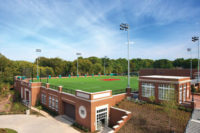Parking Structures: A Forgotten Sustainable Haven

Despite the growth of public transportation and other transportation alternatives, parking locations remain necessary in much of the nation, to the chagrin of some. Even though parking consultants and design teams have been using sustainable practices for parking structures in recent years, many do not calculate energy use as part of their standard methodology.
Unknown to most, a garage typically uses 15 percent of the energy that the building that it is designed to support uses. Worse, this energy use is often lost in the periphery of energy efficiency efforts. Though, parking structures should not be overlooked because the savings potential is immense. Energy use can be reduced by more than 90 percent over an ASHRAE Standard 90.1 2007 baseline parking structure with typical construction costs.
Here are some design elements that can be implemented to improve the energy efficiency of parking structures:
Ventilation
Design the parking structure to maintain an approximate 40 percent façade openness, which allows natural ventilation on all levels. This will be enough ventilation to preclude the need for mechanical ventilation systems.
Daylighting
Lighting is typically the largest load, particularly for naturally ventilated structures. To reduce the lighting load to almost zero during daylight hours, perforate the façade with aluminum panels that reflect in sunlight (while keeping out weather) and, if possible, design to include a “light well” in the middle of the structure to meet a full daylighting effort in the center of the space. If done properly, only a few places in the structure, such as under the stairs, need to be electrically lighted between sunrise and sunset.
Electric Lighting
For nighttime, when lights are needed, include infrared occupancy sensors in each zone. It is important to strategically placed daylight sensors and occupancy sensors to provide a pathway of light for each entering occupant. An advanced lighting control system will also allow for ease of commissioning and retrocommissioning by adjusting fixtures and sensors depending on real occupant patterns.
Equipment
Miscellaneous equipment includes fans for equipment rooms, elevator lighting and ventilation, phones and cameras for security, heat trace for drainpipes, heaters for cameras and fire alarm pull stations, and lighting and fire alarm controls. The estimated annual energy use breakdowns for elevators and miscellaneous equipment are 16 percent and 55 percent respectively. The high miscellaneous electric load is due largely to security equipment, which consumes 29 percent of the total annual energy. Though this level of security might not be necessary for some facilities, these factors can be mitigated.
Using passive means and/or high-efficiency heat pumps for gear, utility and guard room heating can drastically reduce the amount of energy needed. Also consider other high-efficiency equipment, such as security cameras without heaters, regenerative elevators, and guardhouses with heat recovery and occupancy sensors.
Incentives
Energy efficiency incentives include preferred parking for those who carpool, which reduces the amount of lighting and elevator energy use. Biker-friendly access gates and lockers also encourage using alternative transportation, which not only improves overall sustainability, it also reduces the amount of lighting and elevator energy use.
Onsite Renewable Energy Systems
In order to reach the 90 percent potential reduction in parking structure energy use over ASHRAE 90.1 standards, onsite renewable energy generation should be seriously considered. PV panels can be located on a super-structure above the top parking level and potentially on the south-facing façade. Large parking structures can often support more than a megawatt of PV panels, which should provide all the electricity needed for the parking structure and more.
Innovative commercial power purchase agreements (PPAs) for solar electricity is a common way to finance the high upfront cost for solar PV, by agreeing to exchange ownership of the panels to a third party for zero down-payment on the system.
Commissioning
Commission the lighting, parking management and security systems using a system sample approach will ensure that efficiency efforts are working as effectively as possible. For example, lighting system checks help make sure the occupancy sensors are sensitive enough to trigger light for entering occupants, and for occupants rounding corners without false triggers caused by occupants in nearby bays.
Parking structures can be designed and operated very energy efficiently. Whether the structure is new construction or a major retrofit, design considerations can achieve substantial energy savings where they would otherwise be lost. By addressing the ventilation, daylighting, electric lighting, miscellaneous equipment and potential renewable energy production, energy use in parking structures can be almost eliminated. Some parking structures have even achieved LEED Certification for the parking structure
Looking for a reprint of this article?
From high-res PDFs to custom plaques, order your copy today!






